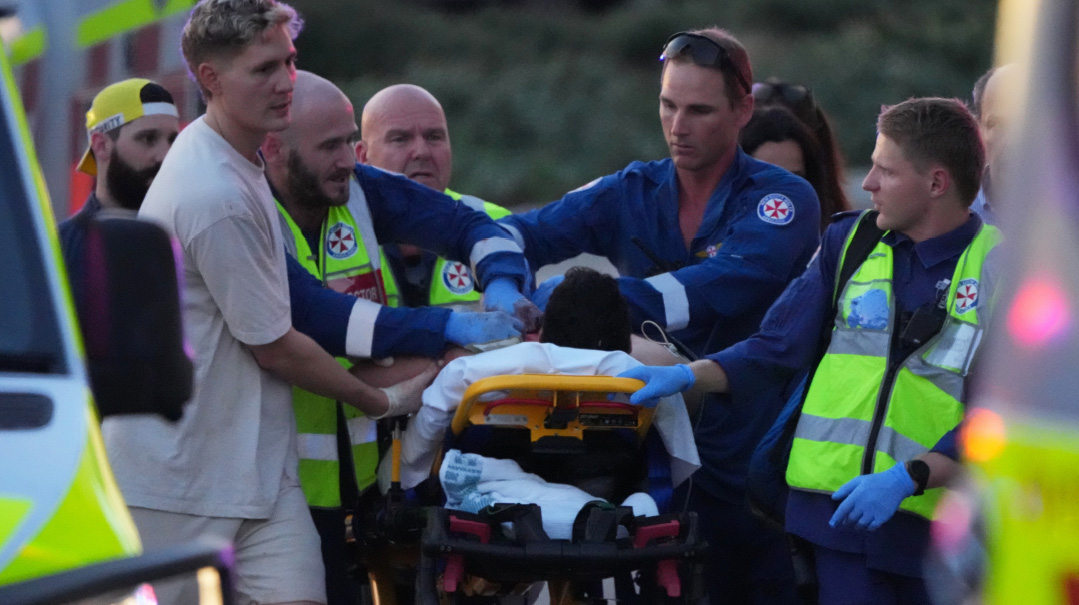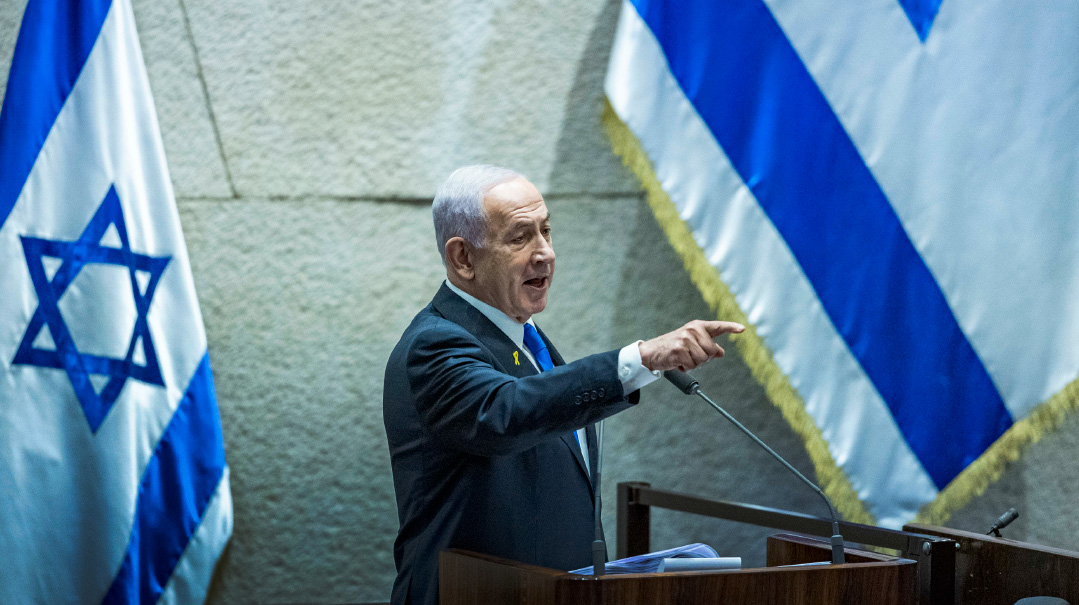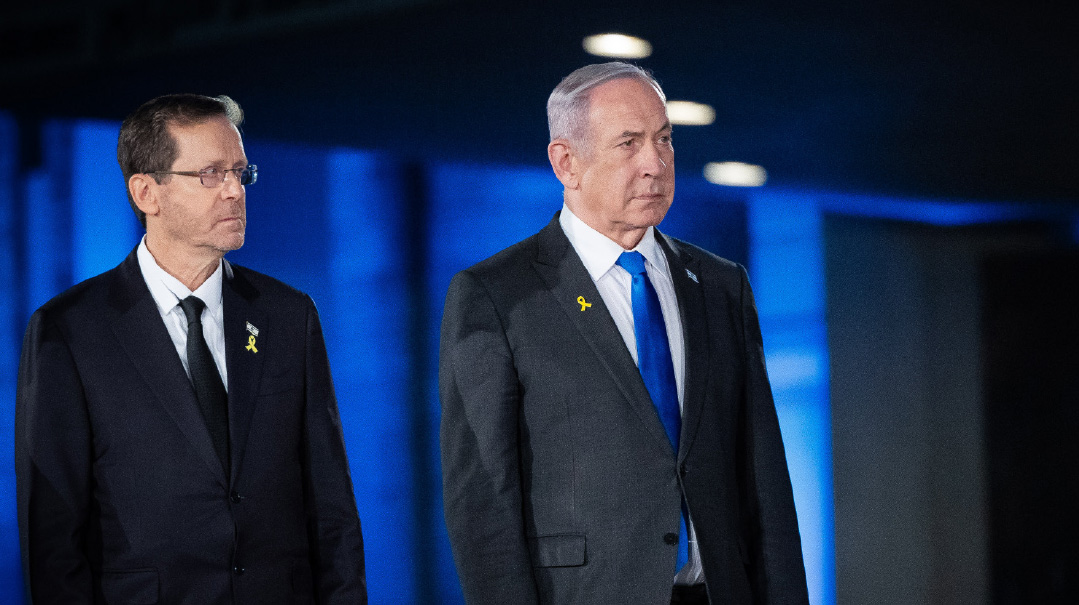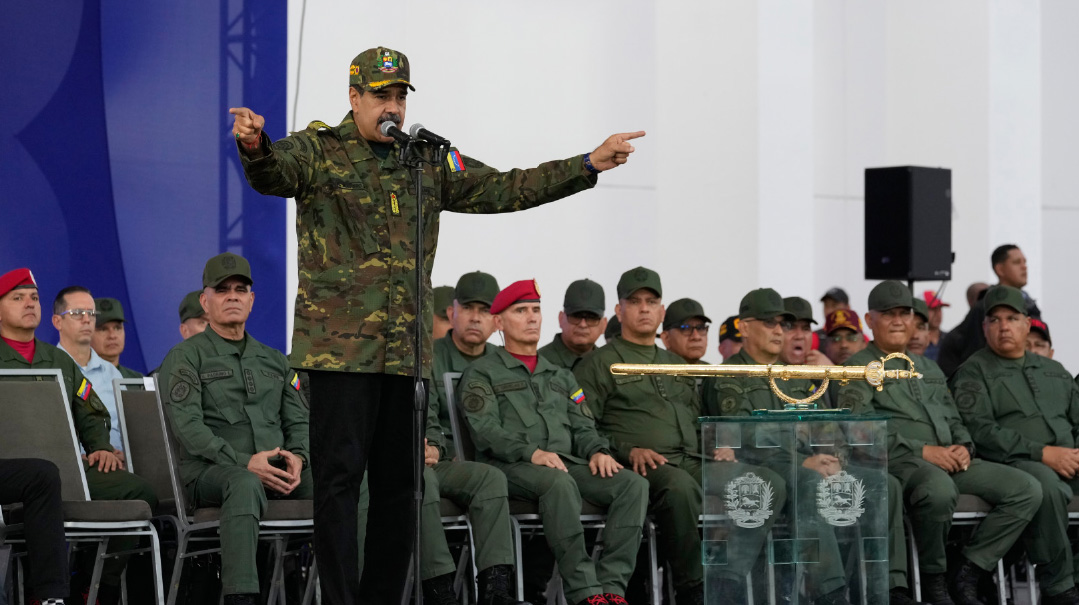In the Lion’s Den
| November 21, 2023Mishpacha’s Kobi Bornstein on the ground in Gaza
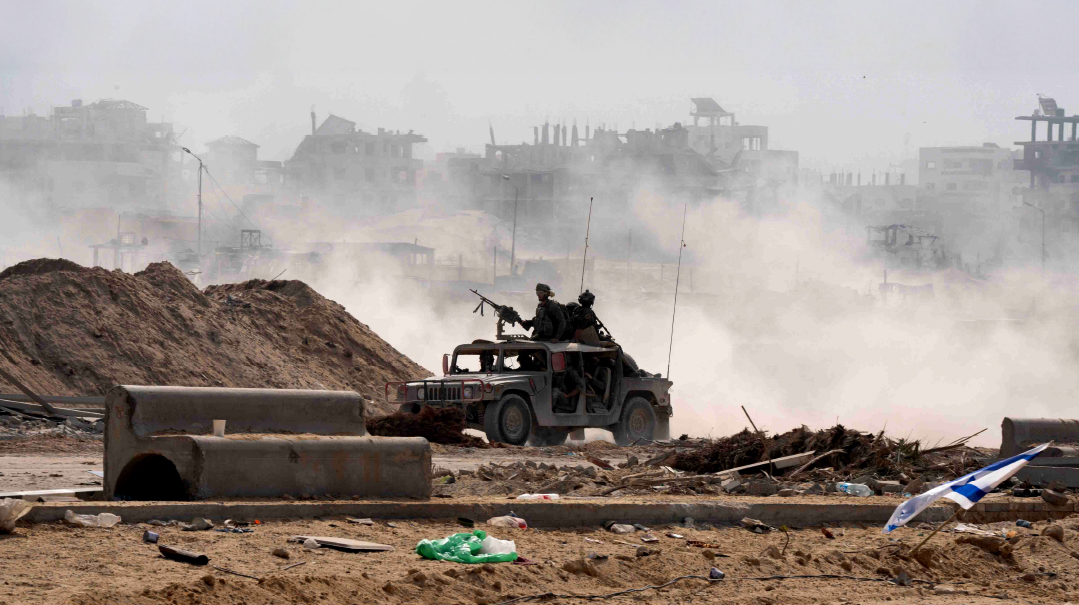
Photo: IDF Spokesman
Deep in the northern Gaza Strip, Mishpacha’s Kobi Bornstein sees a moonscape which hides the Hamas terrorists still active underneath
“Welcome to Gaza,” shouts Yisrael, a reserve soldier, after we cross the barrier from Zikim into the northern Gaza Strip.
Something in the air changes right away. The soldiers who a moment ago were laughing and joshing about the situation are suddenly in a different mood, somber and alert.
The brigade commander fires instructions rapidly. “If there’s an encounter, we get out of the jeep immediately and lie down on the ground. The soldiers in the front will handle it. If there’s a suspicious drone or the possibility of anti-tank fire, we get out of the vehicle and follow the orders we are given. Hands on your weapons, eyes always forward.”
I’ve crossed the fence with IDF forces before, both in Syria and in Lebanon. In both cases, it was for isolated and pinpointed actions near the fence. This is the first time I’ve crossed the border with the clear purpose of going as deep into Gaza as possible, into an active combat zone. For some reason, it doesn’t feel the way I thought it would.
The meeting point with the soldiers was at the Zikim Base, which I am familiar with. In recent operations, I was on the base, sometimes as part of my reserve service. For longer periods, it was the base from which we launched every operation we carried out in the south of Israel and the Gaza Envelope region.
Even though I know the base well, the roads that lead to it are new to me. Due to the fear of anti-tank fire from the Strip, the main roads in the area of Kibbutz Carmiyah and Zikim have been totally blocked, so we detour through fields and orchards. Wherever I look, I can see testimony of the battles waged there on Simchas Torah and the following days. Dozens of terrorists infiltrated here, some of them through breaches in the fence and others over the sea, continuing on their murderous rampage on the Zikim beach, in the kibbutzim, and on the base.
The ground is still littered with thousands of bullet casings, many from Kalashnikovs and other terrorist weapons. Some came from IDF forces that fought back valiantly and killed terrorists left and right. There are deep tank tracks in the dirt, and bullet holes on almost every structure we pass.
The entrance to the base is buzzing with activity. Dozens, perhaps hundreds, of military Hummers are driving in and out, full of soldiers, some on the way to Gaza and some just coming back.
“I used to be able to figure out who was coming out and who was going in, based on the expressions of the soldiers,” the regiment guard tells me. “Look at them now, their morale is all sky-high. You can’t tell who’s going in and who’s coming out. It’s hard to even discern fear here.”
After a moment of silence, he adds, “Actually, maybe you can figure it out based on how worn out they look. The soldiers who come back are much more tired than the ones going in.”
Even for those who have come out of Gaza, it’s only a temporary respite before going back in. They’ll rest up for a few hours, call the wife and children, and then they’ll head back into the Strip.
On the base itself, there are also numerous signs of the battles waged here. Lots of soldiers fell here in battle, and some I knew from my own service. The succah built by the military rabbinate on Erev Succos is still standing. Who has time to take it down in the middle of an existential war? This base was almost captured by the terrorists and only remained in IDF hands because of the courage of the soldiers here; it now serves as one of the main departure points on the way to eradicate Hamas terror.
On the way out of the base sits an open military Hummer, sans armor, waiting for us.
“We’re going into the Strip in this?” I ask the soldiers.
“This is it,” they say. “It’s more than you think.”
We climb into the Hummer, a thin-skinned American jeep-like vehicle, and join a convoy heading for the lion’s den — the most complex battlefield Israel has ever operated in, a place teeming with terrorists above ground and below, emphasis on the latter. The convoy travels quickly. Everyone’s eyes are fixed ahead, to the horizon, and the tension rises.
Strangely, from the minute Yisrael shouts his welcome as we pass through the security fence and enter the Strip at Zikim, the tension begins to ease.
Control of the Area
A few hours earlier, I had accompanied an IDF operation in a village in Judea and Samaria. The village was considered relatively quiet, yet my adrenaline was pumping and I felt much more afraid than I now feel in the Strip. I share this sentiment with the regiment commander.
“It’s perhaps the most significant point in our current operations in the Strip,” he replies. “People on the outside can’t understand it.
“The very fact that you are able to be here now, deep in the Strip, after the refugee camps, at the entrance to Gaza City itself, in an unarmored vehicle, and you feel safe — this is evidence of the IDF’s success so far. Within a few weeks, we’ve cleared a large area. This is an area that no Israeli has set foot in since the Disengagement, an area we did not even reach during Operation Protective Edge in 2014, and in such a short time, we’ve cleared it so thoroughly.”
The atmosphere is different from what I thought it would be. Nevertheless, from the minute I enter the Strip, I can’t miss the fact that it’s still an active warzone. Clouds of smoke drift everywhere, strong explosions shake the ground every minute; there are screams, thundering planes and drones, and echoes of small arms fire. In some cases, the reports are so close to us that we can discern whether they are “friendly fire” or from the terrorists.
The Gaza beachfront stretches off to my right. The Hamas command centers on the coast — located in what was, until the Disengagement, the settlement of Dugit — have been totally bombed out, leaving not even one wall standing. About a kilometer beyond Dugit is what was once an Gaza upscale neighborhood, home to many senior Hamas figures, who lived in magnificent villas overlooking the sea; since the IDF came in, the place has a vast landscape of rubble. One house that it still standing gives testament to the former luxury and grandeur.
“This house that we left belongs to one of the senior Hamas figures in Beit Lahiya,” explains Yisrael, seated at my side with his hand on the trigger of his weapon. “Now it’s an IDF command center, just like the homes of other Hamas figures in the Strip.”
On my left are the buildings of west Beit Lahiya, or what is left of them. Entire streets have been reduced to ruins, dust, and ashes, and the rubble has buried hundreds of terrorists.
“Anything above ground is under absolute Israeli control, from here until Gaza City, which has also been almost totally captured,” the soldiers explain. “The problem is what is going on under the ground, and that’s what we’re working on now.”
The forces are following a well-defined plan of battle: They come to a place that has been marked ahead of time; they clear everything above the ground, demarcate the area and block it off, and then begin to scour it to negate the possibility that there are tunnels underneath. If one is discovered, they work to destroy it. Then they take up positions at this point, and slowly, they expand the radius of operations around it. They have done this at hundreds of various points.
Wherever you look, until the horizon, you see similar gathering areas, with thousands of soldiers. It seems that even when Israel did control Gaza, there weren’t so many forces there.
“There are areas here that certainly have more Israelis than Gazans,” adds Elchanan, a Beitar Illit resident fighting in the reserves.
After a short drive, we reach the regiment’s staging area, south of the Shati camp, north of Gaza City, which lies ahead of us. Take away the smoke and the smell of death and the Gaza Strip could be a real paradise. Huge beaches, ocean breezes, and palm trees. A natural Garden of Eden, which Hamas has turned into an earthly Gehinnom.
The staging area is right at the entrance of the city, in a formerly dense urban environment. Now just four buildings remain, all being used as IDF command centers. The soldiers assemble in the buildings and in the open space between them, while additional forces secure the area and work to expand it.
String of Miracles
“Do you know how to read the Torah?” a soldier suddenly asks me.
He doesn’t even wait for answer. He pulls out a sefer Torah from a special case he wears on his back.
“Krias HaTorah of Rosh Chodesh right now at the pergola,” he calls out loudly.
The pergola, in the heart of a residential area, served until a few weeks ago as a hiding place for rocket launchers. Now it serves as a shelter for reading the Torah on Rosh Chodesh.
It is the most emotional Torah reading I have ever experienced. Seven weeks ago, I was summoned down south on Simchas Torah morning, in the middle of hakafos, before I had even heard leining. Now I’m in the heart of Gaza, a place I never dreamed I’d set foot in, reading the Torah at the top of my lungs —all while feeling safe.
My voice trembles a bit when I begin the leining. From emotion, not from fear. The soldiers who receive aliyos each bentsh hagomel. Every one of them has an amazing story to go with his brachah. One was miraculously spared in a face-to-face clash with terrorists, another was spared from an explosive drone, another had a grenade thrown at him, while a fourth had an anti-tank missile aimed at him. An endless string of miracles brought each of them to this moment.
After the leining, the soldiers burst into renditions of Yehi hachodesh hazeh, and L’shanah haba’ah b’Yerushalayim.
“We sing here all day,” they explain. “It keeps our morale high and helps fight off the exhaustion. The miracle of Gaza is also its drawback. In other places, the soldiers get worn down very quickly because it’s so quiet. When there is a lot of dead time, with no action, the soldiers get worn down. Here, there’s no such thing as a moment without action. There isn’t a second when we aren’t working.”
A Tunnel Under the Bed
A soldier stands at the entrance to a house behind us and motions me quietly to come.
“There’s something you need to see here,” he whispers. Just before we enter, he announces: “This place is completely cleared aboveground, but we can’t completely negate the possibility that there’s something underground. Our eyes need to search constantly, and your weapon needs to be ready and facing forward. If something happens, it’s you and me on our own here. We’re the only ones in this event.”
And as if to underscore the seriousness of what he is saying, there’s a burst of gunfire just a few yards away.
We enter the house. It’s a simple residence on the eastern side of Beit Lahiya. The living room is almost empty.
“They knew we were going to raid the place, so they packed up what they could and left,” he explains.
In one room — likely a child’s bedroom — under the small bed at the side is a tunnel shaft about a meter wide and four meters deep, leading to an underground room. From the evidence, it seems to have served as a weapons and rocket storage area.
“This room can also be accessed through a tunnel dug under a building a bit further away, and there’s a third exit to the open area across the street,” the soldier explains. “This room was almost empty when we got here, and aside from a bit of money and bullet casings, we didn’t find anything.
“But the tunnels that lead to and from it contained grenade launchers, anti-tank rockets, and sophisticated binoculars. Based on the location and the style of digging, we concluded that the tunnels dug from the houses — from this house, as you see, it was dug under the bed in the children’s room, and in the other house, it came right to the living room of the house — served to transport weapons to the storage room in a way that would not arouse suspicions. Because who would suspect that an innocent father bringing boxes into his young daughter’s room is actually a brutal terrorist who lets his kids sleep on tons of explosives?”
Thus, I see firsthand the cruel and cynical way that Hamas uses human shields.
The third tunnel, which led to the open area across the street, apparently was used to move rockets out of the tunnel for launch, and perhaps even as an escape route for terrorists.
“This is the reality we deal with in our day-to-day here,” he continues. “Even though on the outside, the area looks clear, and wherever you look you see IDF soldiers, under the ground there are still thousands of terrorists. Some of them are in places where the ground above has even been cleared. We haven’t yet been able to neutralize the threats beneath us. And that’s part of our work now.”
Fighting Like Lions
From there, the soldiers continue to operations within the Shati refugee camp. “This is a place that was extremely densely populated, and as you can see now, it’s rather open, under the cover of the Air Force and the Armored Corps, and therefore it’s easier for us to work here. But there was just a clash with terrorists who emerged from a tunnel in one of the places we have not yet thoroughly combed. The soldiers killed the terrorists, and now we are going to scan the area to figure out where they came from and neutralize this threat permanently.”
On the way back, we pass again through Beit Lahiya. What was once a dense urban neighborhood has become a huge expanse of rubble. Here and there you still hear the sounds of battle, which fade as we advance northwards.
“Even if you come in here with closed eyes, based on the sounds, you will be able to hear where we have 100 percent control and where we are still fighting,” says Elchanan, sitting in the driver’s seat and skillfully navigating among the ruins.
On the sides of the road, we can see the remains of cars that were bombarded, bullet casings, rocket shrapnel, and of course, destroyed buildings. A sign with the word “Rafah” written in Arabic is thrown on the side of the road. A new sign is up, in Hebrew, noting the exact location for the benefit of the IDF forces.
To my left, the soldiers have put up the Israeli flag on what was once the command center of the Hamas naval forces , and in general, there seem to be Israeli flags on every building still standing in this part of the Strip; they are also waving from every square and on every flagpole.
On my exit from the Strip, just before I part from the soldiers, they ask me to share a message with the readers.
“Tell them we are fighting like lions. The orders we got was to ‘release the wild animal’ and believe me, we’ve done so. As you saw for yourself, we are in control of the area, and are rapidly expanding the area under our control. As we do so, we are killing thousands of terrorists.
“We are strong and determined, and we don’t look back. But we need from you, on the home front, two things: your tefillos and your high morale. Give these to us, and we’ll take care of the rest.”
(Originally featured in Mishpacha, Issue 987)
Oops! We could not locate your form.

